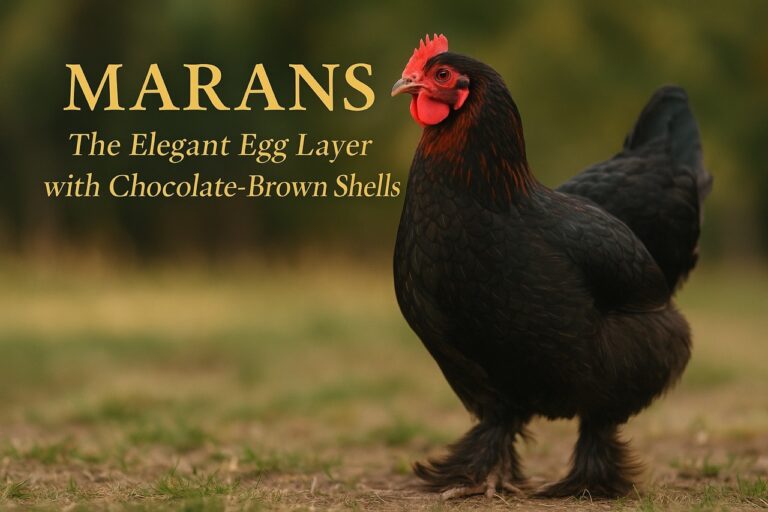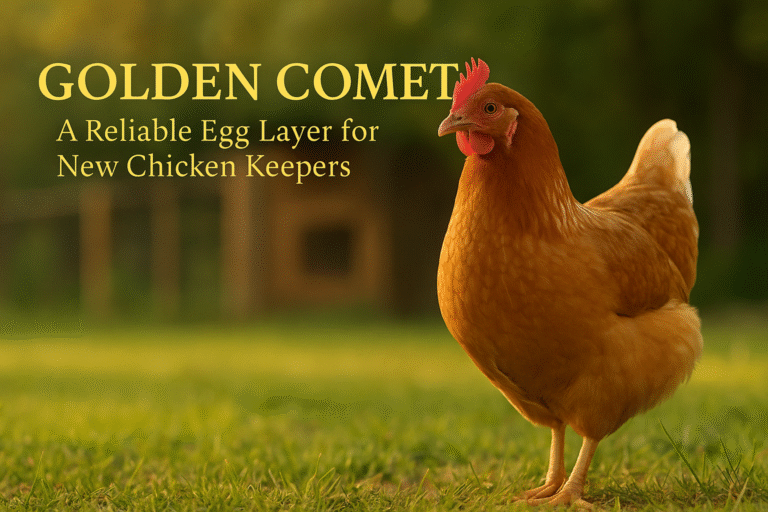In Southeastern U.S. gardens, winter doesn’t mean your soil has to rest — and neither do your chickens. The region’s mild winters make it the perfect environment for multi-purpose Best Winter Cover Crop Mixes that enrich the soil, prevent erosion, suppress weeds, and offer nutritious forage for backyard flocks.
This guide breaks down the most effective winter cover crop blends, tailored for sustainable gardeners who want the best of both worlds: healthy soil and happy hens.
🌾 Why Use Cover Crop Mixes?
Mixing cover crops gives you the best of several plant traits—fast growth, deep roots, nitrogen fixation, and weed suppression—all while standing up to winter grazing.
- 🧪 Improves Soil Structure & Fertility
- 🛡 Protects Against Erosion & Weeds
- 🐔 Provides Winter Forage for Chickens
- 🔁 Encourages Natural Regrowth in Spring
🥇 1. Winter Rye + Austrian Winter Peas + Daikon Radish
Best for: Deep soil improvement, nitrogen boost, and erosion control
- Winter Rye grows fast and thick, choking out weeds and anchoring soil.
- Austrian Winter Peas fix nitrogen and feed your soil.
- Daikon Radish breaks up compacted soil with long taproots (“bio-tillage”).
🪴 Chicken Benefit: Chickens forage rye and peas happily, but usually leave radishes alone—preserving soil structure.
🌾 2. Winter Wheat + Crimson Clover + Hairy Vetch
Best for: Nitrogen-rich soil and heavy winter rain protection
- Winter Wheat is cold-hardy and great for biomass.
- Crimson Clover adds nitrogen and blooms beautifully in early spring.
- Hairy Vetch spreads as a vine, filling bare spots and fixing nitrogen.
🪴 Chicken Benefit: Chickens enjoy nibbling wheat and clover. Vetch survives light scratching and decomposes into natural fertilizer.
🌱 3. Winter Rye + Crimson Clover + Annual Ryegrass
Best for: Fast cover, nitrogen-fixing, and winter resilience
- Rye and Ryegrass germinate quickly, forming a dense mat.
- Crimson Clover supports nitrogen cycling and early pollinator food.
🪴 Chicken Benefit: This mix bounces back after light grazing. Chickens love the clover and ryegrass without stressing the system.
🌿 4. Annual Ryegrass + Austrian Winter Peas + Mustard Greens
Best for: Pest suppression, protein forage, and diverse biomass
- Annual Ryegrass stabilizes and outcompetes weeds.
- Winter Peas enrich the soil and serve as high-protein forage.
- Mustard Greens suppress soil pests (biofumigation effect).
⚠️ Chicken Note: Mustard greens are fine in moderation. Too much can upset digestion—limit access or rotate grazing.
🍂 5. Buckwheat + Oats (Fall-Only Blend)
Best for: Pre-winter weed control and quick biomass
- Buckwheat grows in 30 days, shades weeds, and adds green manure.
- Oats contribute soft root structure and help suppress erosion.
🪴 Chicken Benefit: Chickens love both crops, and they’ll break down naturally after frost, enriching the soil without tilling.
🌱 How to Plant and Manage Cover Crop Mixes
Seeding & Spacing:
- Reduce seeding rates by 20–25% per species in mixes to prevent overcrowding.
- Mix seeds in a bucket and broadcast evenly across prepared soil.
- Rake lightly to cover to about ¼–½ inch depth.
Protecting Germination:
- Use light straw mulch to deter chickens from scratching.
- Consider temporary fencing until sprouts are 3–4 inches tall.
Grazing Tips:
- Rotate chickens across zones to avoid overgrazing.
- Monitor mustard-heavy mixes or legumes that could be over-consumed.
🔁 Spring Management & Self-Reseeding
- Mow or till cover crops 2–3 weeks before spring planting.
This allows biomass to decompose and enrich your beds naturally. - Let clover or vetch reseed by allowing them to flower before termination.
✅ Summary: Best Mixes by Goal
| Garden Goal | Recommended Mix |
|---|---|
| Deep Soil Aeration + Nitrogen | Rye + Peas + Daikon Radish |
| Pollinator + Nitrogen Boost | Wheat + Crimson Clover + Hairy Vetch |
| Quick Cover + Forage | Rye + Clover + Ryegrass |
| Pest Control + High Protein | Ryegrass + Peas + Mustard Greens |
| Fast Fall Weed Suppression | Buckwheat + Oats (Fall-only) |
🐓 Final Thoughts
Using a smart mix of winter cover crops tailored to Southeastern gardens gives your soil time to heal and your chickens time to snack—all without synthetic inputs. From bio-tillage to nitrogen cycling to chicken-friendly forage, these blends work with nature, not against it.
A healthy flock starts with healthy soil.
A healthy spring starts with a smart winter.
📚 Further Reading on Paranoid Prophet
- 🐔 Winter Chicken Memes and Facts
- 🌾 Wheatgrass Hay & Winter Chickens
- 🧠 Backyard Chickens & Mental Health
- 🌱 How Many Chickens to Start With
Sources
Implementing winter cover crops in the Southeastern U.S. can significantly enhance soil health and provide valuable forage for free-range chickens. The following external resources offer comprehensive guidance on selecting and managing appropriate cover crops for this region:
- Winter Annual Cover Crops – NC State Extension Publications
This publication provides detailed information on winter annual cover crops suitable for the Southeast, including species like cereal rye, crimson clover, and Austrian winter peas. It discusses planting dates, seeding rates, and the specific benefits each crop offers for soil health and erosion control. - Cover Crops Chickens Eat: Using Cover Crops for Chicken Feed – Gardening Know How
This article explores the advantages of growing cover crops such as buckwheat and cowpea for chicken feed. It emphasizes the benefits of allowing chickens to forage freely on these crops, which enhances their nutrition and contributes to natural soil fertilization through their manure. - Winter Cover Crops for North Carolina – NC State Extension
This resource lists suitable winter cover crops for North Carolina, including legumes like crimson clover and Austrian winter pea, as well as non-legumes such as cereal rye and barley. It offers insights into the benefits of each crop and considerations for their use in sustainable farming practices. - Cover Crops Provide Natural Feed for Free-Range Chickens – True Leaf Market
This article discusses how integrating cover crops like alfalfa and clover into your garden can provide natural feed for free-range chickens. It highlights the symbiotic relationship between cover crops and chickens in producing nutrients needed for main-season crops, preserving soil structure, and reducing soil erosion over time.
These resources offer valuable insights into selecting and managing winter cover crops in the Southeastern U.S., benefiting both soil health and free-range chicken foraging.
FAQ: Best Winter Cover Crop Mixes
General Questions About Winter Cover Crops
- What are the best winter cover crop mixes for the Southeast?
The best winter cover crop mixes for the Southeast typically include a combination of grasses (like rye or oats), legumes (such as crimson clover or Austrian winter peas), and brassicas (like forage radishes). These mixes thrive in mild winters and improve soil health while preventing erosion. - Why should I plant a winter cover crop mix?
Winter cover crop mixes offer numerous benefits, including preventing soil erosion, improving soil fertility, suppressing weeds, and providing organic matter for future crops. They are an excellent investment for maintaining healthy soil during the colder months. - When should I plant winter cover crops in the Southeast?
Winter cover crops should be planted in the Southeast from late September to November, depending on your local frost dates. Planting at the right time ensures that the crops establish before cold weather sets in. - How do I choose the right winter cover crop mix?
Consider your goals, such as weed suppression, nitrogen fixation, or soil erosion control. Also, take into account your region’s climate, soil type, and whether you’ll terminate the cover crop manually or with livestock grazing.
Specific Crops in Cover Mixes
- What makes crimson clover a good winter cover crop?
Crimson clover is a nitrogen-fixing legume that enriches the soil and attracts pollinators. It grows well in the Southeast’s mild winters and is a great addition to any cover crop mix. - Are cereal rye and oats interchangeable in cover crop mixes?
Both cereal rye and oats are excellent choices for winter cover crops, but they serve slightly different purposes. Rye is more cold-tolerant and provides better weed suppression, while oats are easier to terminate and break down faster, offering quicker organic matter. - What role do forage radishes play in winter cover crop mixes?
Forage radishes help break up compacted soil with their deep taproots, improving drainage and aeration. They also scavenge nutrients from deeper layers, making them available for future crops. - Can I mix legumes with grasses for winter cover crops?
Yes, mixing legumes with grasses is highly beneficial. Legumes, like clover or peas, fix nitrogen, while grasses, such as rye or oats, prevent erosion and provide biomass for organic matter.
Planting and Maintenance
- How do I plant a winter cover crop mix?
Prepare the soil by removing weeds and debris. Broadcast the seeds evenly and lightly rake or roll the soil to ensure good seed-to-soil contact. Water the area if there’s no rain in the forecast. - Do I need to fertilize my winter cover crops?
Most winter cover crops don’t require additional fertilization, especially if legumes are included, as they fix nitrogen. However, poor soils may benefit from a light application of fertilizer to help crops establish. - How do I manage cover crops in the spring?
Terminate your cover crops 2–4 weeks before planting your spring crops. This can be done by mowing, tilling, or using livestock grazing. Allow time for the residue to decompose and enrich the soil.
Livestock and Pollinator Benefits
- Can I use winter cover crops as forage for livestock?
Yes, many winter cover crops, such as cereal rye, oats, and forage radishes, are excellent forage options for livestock. They provide nutritional grazing opportunities while still benefiting the soil. - Do winter cover crops attract pollinators?
Legumes like crimson clover and hairy vetch bloom in late winter and early spring, providing essential nectar and pollen for pollinators when other food sources are scarce.
Environmental and Soil Health Benefits
- How do winter cover crops improve soil health?
Winter cover crops prevent erosion, add organic matter, fix nitrogen, and improve soil structure. Their roots stabilize the soil, while their residue feeds beneficial microbes. - Can winter cover crops reduce my need for fertilizers?
Yes, cover crops, particularly legumes, fix nitrogen naturally, reducing the need for synthetic fertilizers. They also recycle nutrients and enhance soil fertility, benefiting future crops.




